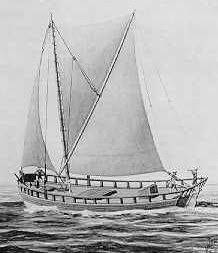This Week in Petroleum History: July 21 – 27
July 21, 1935 – “Diamond Glenn” McCarthy strikes Oil –
Glenn H. McCarthy struck oil 50 miles east of Houston in 1935, extending the already prolific Anahuac field. The well was the first of many for the Texas independent producer who would discover 11 Texas oilfields by 1945.
McCarthy became known as another “King of the Wildcatters” and “Diamond Glenn” by 1950, when his estimated worth reached $200 million ($2 billion today).
In addition to his McCarthy Oil and Gas Company, McCarthy eventually owned a gas company, a chemical company, a radio station, 14 newspapers, a magazine, two banks, and the Shell Building in Houston. In the late 1940s, he invested $21 million to build the 18-story, 1,100-room Shamrock Hotel — and reportedly spent $1 million on its St. Patrick’s Day 1949 opening gala, which newspapers dubbed “Houston’s biggest party.”
Learn more in “Diamond Glenn” McCarthy.
July 22, 1933 – Phillips Petroleum sponsors Flight around the World
Before 50,000 cheering New York City onlookers, former roughneck Wiley Post landed his Lockheed 5C Vega “Winnie Mae,” becoming the first person to fly solo around the world. Post had worked in oilfields near Walters, Oklahoma, when he took his first airplane ride with a barnstormer in 1919 and was inspired to take lessons.
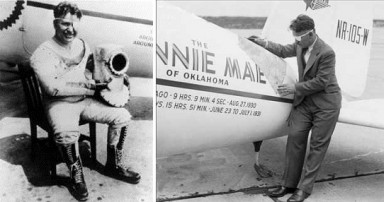
Thanks to a friendship with Frank Phillips, Wiley Post set altitude records and became the first person to fly solo around the world.
In 1926, on the first day of working at a well near Seminole, a metal splinter severely damaged his left eye, causing loss of sight. Post used the $1,700 in compensation to buy his first airplane. He became friends with Frank Phillips, president of Phillips Petroleum, sponsor of several high-altitude experimental flights. Phillips also sponsored the “Woolaroc” — winning plane of an August 1926 air race across the Pacific.
July 22, 1959 – Marker erected for Second U.S. Oil Well
The Pennsylvania Historical and Museum Commission dedicated a state marker to commemorate the man who drilled for oil just a few days after Edwin Drake completed the first U.S. commercial well on August 27, 1859. “After Drake’s discovery of oil in Titusville, some area residents attempted to sink their own well,” noted historians at Explore Pennsylvania. “The vast majority of such efforts failed.”
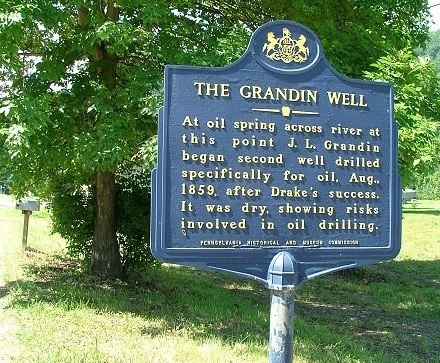
Pennsylvania historical marker for the 1859 Grandin well — America’s second oil well, which was a dry hole.
Using a simple spring pole, 22-year-old John Grandin and a local blacksmith began to “kick down” a well that would reach almost twice as deep as Drake’s cable-tool depth of 69.5 feet. Despite not finding the oil-producing formation (the Venango Sands), Grandin’s well produced several “firsts” for the young U.S. petroleum industry.
Learn more in First Dry Hole.
July 23, 1872 – “Real McCoy” Steam-Engine Lubricator
Using petroleum for improving the performance of locomotives became widespread when Elijah McCoy patented an automatic lubricator for steam engines. McCoy designed a device that applied oil through a drip cup to locomotive and ship steam engines. Instead of stopping engines to apply necessary lubrication, McCoy’s device provided it while they ran, saving railroads time and money.
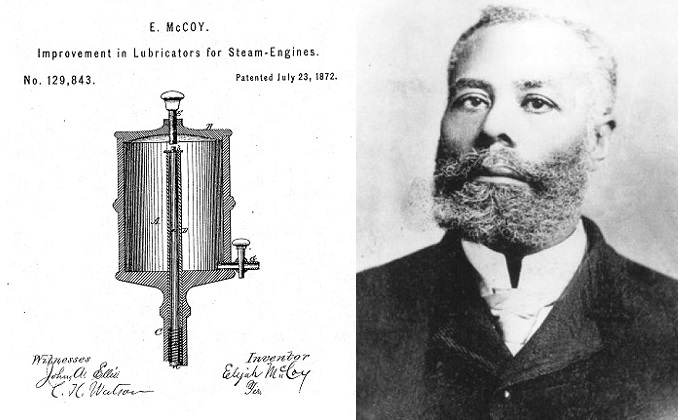
Elijah McCoy invented lubrication systems for steam engines, early beneficiaries of petroleum. Awarded more than 60 patents, he was inducted into the National Inventors Hall of Fame in 2001.
The Canadian-born McCoy was the son of slaves who had escaped Kentucky. After his family settled in Michigan, 15-year-old McCoy traveled to Scotland to study mechanical engineering. By the time he died in 1929, the inventor had received 60 patents, according to a 1994 Michigan historical marker.
The expression “the real McCoy” reportedly came from railroad engineers not wanting to buy low-quality copycats of his popular device. Before purchasing the lubricator, buyers would ask if it was “the real McCoy.”
July 23, 1951 – Desk & Derrick Clubs organize
After a secretary at Humble Oil and Refining Company organized the first club in New Orleans, the Association of Desk & Derrick Clubs (ADDC) of North America officially began with articles of association signed by the presidents of clubs in Jackson, Mississippi, New Orleans, Los Angeles, and Houston. By 1952, representatives from 40 clubs would attend the first ADDC convention, held at Houston’s Shamrock Hotel.
Learn more in Desk and Derrick Educators.
July 24, 2000 – BP unveils New Green and Yellow Logo
BP — the official name of a group of companies including Amoco, ARCO and Castrol — unveiled a new corporate identity brand, replacing the “Green Shield” logo with a green and yellow sunflower pattern.
The company also introduced a new corporate slogan: “Beyond Petroleum.” When BP — then British Petroleum — merged with Amoco in 1998, the company’s name briefly changed to BP Amoco before all stations converted to the BP brand.
July 25, 1543 – Oil reported in New World
The first documented report of oil in the New World resulted when a storm forced Spanish explorer Don Luis de Moscoso to land two of his brigantines at the mouth of the Sabine River. He had succeeded expedition leader Hernando de Soto and built seven of the small vessels to sail down the newly discovered Mississippi River and westward along the Gulf Coast.
According to an account of the expedition, Indians knew of the future Texas’ natural seeps. “There was found a skumme, which they call Copee, which the Sea casteth up, and it is like Pitch, wherewith in some places, where Pitch is wanting, they pitch their ships; there they pitched their Brigandines.”
Learn more about the first reports of oil worldwide in Earliest Signs of Oil.
July 27, 1918 – Standard Oil of New York launches Concrete Tanker
America’s first concrete vessel designed to carry oil, the Socony, left its shipyard at Flushing Bay, New York. Built for the Standard Oil Company of New York, the barge was 98 feet long with a 32-foot beam and carried oil in six center and two wing compartments, “oil-proofed by a special process,” according to the journal Cement and Engineering News.
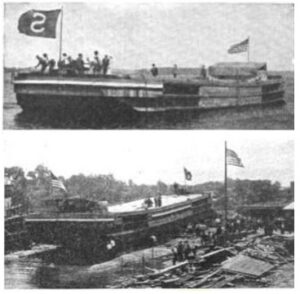
Socony, the first concrete oil tanker, launched in 1918. Below is a second version of the oil barge.
“Eight-inch cast iron pipe lines lead to each compartment and the oil pump is located on a concrete pump room aft,” the journal explained. Steel shortages during World War II would lead to the construction of larger reinforced concrete oil tankers.
_______________________
Recommended Reading: The Big Rich: The Rise and Fall of the Greatest Texas Oil Fortunes (2009); From Oklahoma to Eternity: The Life of Wiley Post and the Winnie Mae
(1998); Myth, Legend, Reality: Edwin Laurentine Drake and the Early Oil Industry
(2009); Western Pennsylvania’s Oil Heritage
(2008); Trek of the Oil Finders: A History of Exploration for Petroleum (1975); Anomalies, Pioneering Women in Petroleum Geology, 1917-2017; Breaking the Gas Ceiling: Women in the Offshore Oil and Gas Industry (2019). Your Amazon purchase benefits the American Oil & Gas Historical Society. As an Amazon Associate, AOGHS earns a commission from qualifying purchases.
_______________________
The American Oil & Gas Historical Society (AOGHS) preserves U.S. petroleum history. Please become an AOGHS annual supporter and help maintain this energy education website and expand historical research. For more information, contact bawells@aoghs.org. © 2025 Bruce A. Wells. All rights reserved.





